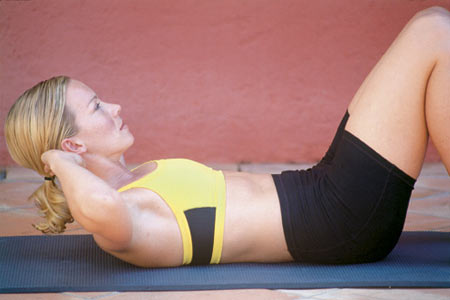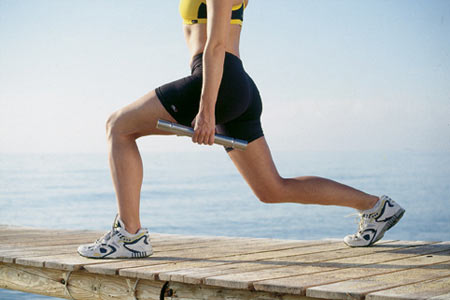
As a diver, you are reliant on your body as well as your gear for a safe and enjoyable dive—so make sure both are well maintained. Diving regularly helps keep you in shape, but it is important to maintain your fitness levels if you go for long periods without diving.
How fitness affects diving
Staying in shape reduces some of the risks associated with diving, and makes it more enjoyable. Having healthy lungs and an efficient circulatory system means you will use less air, so dives last longer. A good level of cardiovascular fitness will also help to prevent panic attacks, which can be triggered by a buildup of carbon dioxide in the blood. A fit body will expel this by-product of respiration more efficiently, reducing that risk. General strength is required for lifting equipment and other incidental tasks. Maintaining a healthy weight for your size is also advisable. When you dive, nitrogen builds up in the tissues of your body with each intake of breath, and fat retains nitrogen longer than all other tissue types. Therefore, if you are overweight and breathe rapidly because you are out of shape, you expose yourself to an increased risk of DCS . Weight loss and gain can also alter your buoyancy. Fat is inherently buoyant, so if you have put on or lost a lot of weight since your last dive, you must adjust how much lead weight you carry as ballast.
Developing a fitness regimen
There is no quick fix for getting and staying fit. Aim to exercise regularly, tailoring your routine to strengthen the muscles you use most during diving: those of your back, legs, shoulders, and arms. If you do not already exercise regularly, seek medical advice before embarking on a fitness routine. Start gently with easy exercises, and build up slowly. A routine based on the exercises overleaf could start, for example, with ten repetitions of each, building up to 50, three times a week. You should also aim to undertake regular cardiovascular exercise (such as walking or cycling), for 30 minutes two or three times a week to improve your general fitness and respiratory health. Whatever exercise routine you decide to adopt, try to incorporate it into your normal daily routine wherever possible. A walk to work every day does more good than a monthly gym session. Never exercise after diving. This is a time when it is important not to do any strenuous activities—there is still residual nitrogen in your body, and this may form bubbles if you exercise too hard. Do some gentle stretches and take it easy for the rest of the day. Avoid hot baths or showers after diving, since these can also raise your vulnerability to DCS.
Warming up
Always warm up and stretch—especially your thighs, calves, and upper and lower back—before exercising, and spend a few minutes gently stretching and
cooling down afterward. Many sporting injuries are caused by failure to warm up properly, so treat it as an important part of your fitness routine.
Arm and leg exercises
Basic squats build up strength in your legs. Standing upright with your feet shoulder-width apart and your knees soft, place your hands on your hips and shift the weight back into your heels. Keeping your head and chest pointing forward and your back straight, bend at the hip and knees, as if you were sitting down onto a chair. Keep your heels on the floor; you should be able to move your toes, since all your weight is on your heels. Straighten and repeat. Lunges are a more advanced exercise for legs. Stand upright with one foot a good stride in front of the other, with your hips parallel and your toes forward. Your back heel should be off the ground and your front foot flat on the floor. Both knees should be bent and your back straight. Drop your body weight toward the floor until your front knee is bent at a 90° angle. You may have to tilt your pelvis forward to get this position right. Rise up and repeat. Biceps curls strengthen the biceps— muscles in the upper arms that are used whenever you lift anything. Using hand weights or a weighted bar, stand upright, with your back straight and knees slightly soft, and hold the weights in your hands with your palms facing upward. Without rocking or moving your shoulders, bend the arms toward the chest and then lower, taking care not to lock the elbows.

Basic push-up
The push-up is a great all-around exercise for the upper body and arms. Beginners can start with their knees resting on the ground.
Exercising your torso
Push-ups strengthen your shoulders, upper body, and core muscles. Lying on your front, bend your knees, curl your toes under your feet, and place your hands shoulder-width apart below your shoulders. Press your body weight up and down from this position. Keep your back straight at all times and your elbows pointing out to the sides. Crunches strengthen abdominal muscles, which will help protect your lower back. Lying on your back, bend your knees slightly and place the soles of your feet on the floor. Place your fingertips behind your ears and lift your upper torso and shoulders off the floor. Hold this for three to five seconds while looking forward, then lower and repeat.

Abdominal crunch
Always keep your lower back flat on the floor and never arched. For a harder workout, aim your right elbow to your left knee, and vice versa.

Lunge exercise
Practicing lunges in front of a mirror will help you to get the position of your front leg right: knee directly over foot, bent to a right angle
I would strongly recommend to visit this website about bodybuilding for making all exercises in correct form , Scooby is a great guy and he’ll give you correct advice if it will be needed. Do not overdo keep in mind that we are divers and not bodybuilders , but this website will help you to do all exercises in correct form and thus it will help you to prevent injuries . As for me the most important exercises are Push-ups and Pull-up do them always.